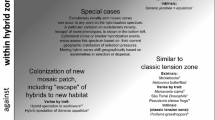Abstract
In a spatial simulation we show that formation of a stable, narrow hybrid zone requires no selection, only that individuals can recognize their own population type since this is a prerequisite for assortative mating. The European crow occurs in two species/subspecies that meet in a long hybrid zone, the black carrion crow Corvus corone and the grey and black hooded crow C. cornix. In a previous study (Brodin A, Haas F (2006) Anim Behav 72:139) we mimicked sexual imprinting in nestling crows with artificial neural networks, using a learning process that simulates proximate retina perception. The networks were trained on 700 images to recognize either carrion, hooded or hybrid phenotypes as their own. After training the networks were exposed to 300 new, unfamiliar pictures of crows. The networks that had been trained on pure subspecies then showed strong preference for their own type. Networks trained on hybrid crows showed weaker preference for their own type. Assuming that these preferences will determine mate choice preferences we have combined them with empirical data on dispersal of young crows to investigate what kind of geographical distribution pattern this would create. We then assume that the two subspecies meet and hybridize along a straight border. In only 60 generations a stable, narrow hybrid zone that resembles the real hybrid zone was formed. This zone remained stable over time. With minor adjustments of parameters the results would not only fit the width but also the shapes of the clines in the field.








Similar content being viewed by others
References
Barton NH, Gale KS (1993) Genetic analysis of hybrid zones. In: Hybrid zones and the evolutionary process. Harrison RG Oxford University Press, New York, pp 13–45
Barton NH, Hewitt GM (1985) Analysis of hybrid zones. Annu Rev Ecol Syst 16:113–148
Barton NH, Hewitt GM (1989) Adaptation, speciation and hybrid zones. Nature 341:497–503
Bateson RPG (1966) The characteristics and context of imprinting. Biol Rev 41:177–220
Bigelow RS (1965) Hybrid zones and reproductive isolation. Evolution 19:449–458
Bischhof H-J (1998) Sexual imprinting as a two stage process. In: Hogan JA, Bolhuis JJ (eds) Causal mechanisms of behavioral development. Cambridge University press, Cambridge
Brodin A, Haas F (2006) Speciation by perception. Anim Behav 72:139–146
Chalmers N (1983) Development of social relationships. In: Halliday TR, Slater PJB (eds) Animal behaviour. Blackwell Scientific Publications, Oxford, pp 114–148
Cook A (1975) Changes in the Carrion/Hooded Crow hybrid zone and the possible importance of climate. Bird Study 22:165–168
Cramp S, Perrins CM (1994) Crows to Finches. Handbook of the birds of Europe, the Middle East and North Africa. Oxford University Press, Oxford, pp 172–195
Haas F, Brodin A (2005) The Crow Corvus corone hybrid zone in southern Denmark and northern Germany. Ibis 147:649–656
Harrison RG (1993) Hybrids and hybrid zones: a historical perspective. In: Hybrid zones and the evolutionary process. Harrison RG Oxford University Press, New York, pp 3–12
Hatfield T, Schluter D (1999) Ecological speciation in sticklebacks: environment-dependent hybrid unfitness. Evolution 53:866–873
Howard DJ (1993) Reinforcement: origin, dynamics and fate of an evolutionary hypothesis. In: Hybrid zones and the evolutionary process. Harrison RG Oxford University Press, New York, pp46–69
Hubbs CL (1955) Hybridization between fish species in nature. Syst Zool 4:1–20
Irwin DE, Price T (1999) Sexual imprinting, learning and speciation. Heredity 82:347–354
Kendrick KM, Da Costa APC, Broad KD, Ohkura S, Guevara R, Lévy F, Keverne EB (1998) Neural control of maternal behaviour and olfactory recognition of offspring. Brain Res Bull 44:383–395
Key KHL (1968) The concept of stasipatric speciation. Syst Zool 17:14–22
Kirkpatrick M, Ravigné V (2002) Speciation by natural and sexual selection: models and experimnets. Am Nat 159:S22–S35
Loman J (1984) Breeding success in relation to parent size and experience in a population of the hooded crow. Ornis Scand 15:183–187
Mayr E (1947) Ecological factors in speciation. Evolution 1:263–288
Mayr E (1963) Animal species and evolution. Harvard University Press, Cambridge, Mass
Meise W (1928) Die Verbreitung der Aaskrähe (Formenkreis Corvus corone L.). J Ornithol 76:1–203
Mundy NI, Badcock NS, Hart T, Scribner K, Janssen K, Nadeau NJ (2004) Conserved genetic basis of a quatitative plumage trait involved in mate choice. Science 303:1870–1873
Penn D, Potts W (1998) MHC-disassortative mating preferences reversed by cross-fostering. Proc R Soc Lond B Biol Sci 265:1299–1306
Polechkova J, Barton NH (2005) Speciation through competition: a critical review. Evolution 59:1194–1210
Price T (1998) Sexual selection and natural selection in bird speciation. Philos Trans R Soc Lond Biol 353:251–260
Randler C (2002) Avian hybridization, mixed pairing and female choice. Anim Behav 63:103–119
Rice WR (1987) Speciation via habitat specialization: the evolution of reproductive isolation as a correlated character. Evol Ecol 1:301–314
Risch M, Andersen L (1998) Seelktive Partnerwahl der Aaskrähe (Corvus corone) in der Hybridisierungszone von Rabenkrähe (C.c.corone) und Nebelkrähe (C.c.cornix). J Ornithol 139:173–177
Roslik GV, Kryukov AP (2001) A karyological study of some corvid birds/Corvidae, Aves). Russ J Genet 37:796–806
Saino N, Villa S (1992) Pair composition and reproductive success across a hybrid zone of carrion crows and hooded crows. Auk 109:543–555
Siefke A (1994) Wanderungen ostdeutscher Raben- und Nebelkrähen Corvus corone nach Beringungsergebnissen. Vogelwelt 115:83–89
tenCate C, Vos DR, Mann N (1993) Sexual imprinting and song learning, two of one kind. Neth J Zool 43:34–45
ten Cate C, Vos DR (1999) Sexual imprinting and evolutionary processes in birds: a reassessment. Adv study behav 28:1–31
Verzijden MN, Lachlan RF, Servedio MR (2005) Female mate-choice behavior and sympatric speciation. Evolution 59:2097–2118
Author information
Authors and Affiliations
Corresponding author
Additional information
An erratum to this article can be found at http://dx.doi.org/10.1007/s10682-007-9238-9
Rights and permissions
About this article
Cite this article
Brodin, A., Haas, F. Hybrid zone maintenance by non-adaptive mate choice. Evol Ecol 23, 17–29 (2009). https://doi.org/10.1007/s10682-007-9173-9
Received:
Accepted:
Published:
Issue Date:
DOI: https://doi.org/10.1007/s10682-007-9173-9




